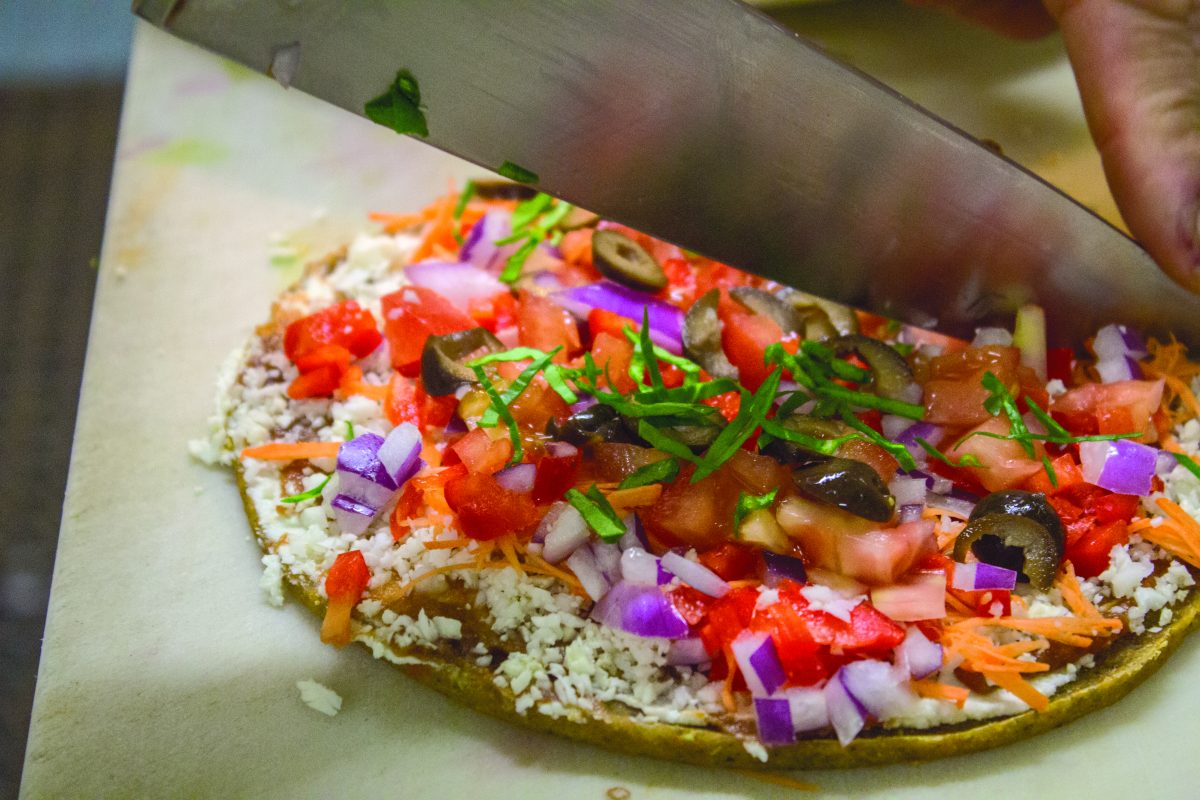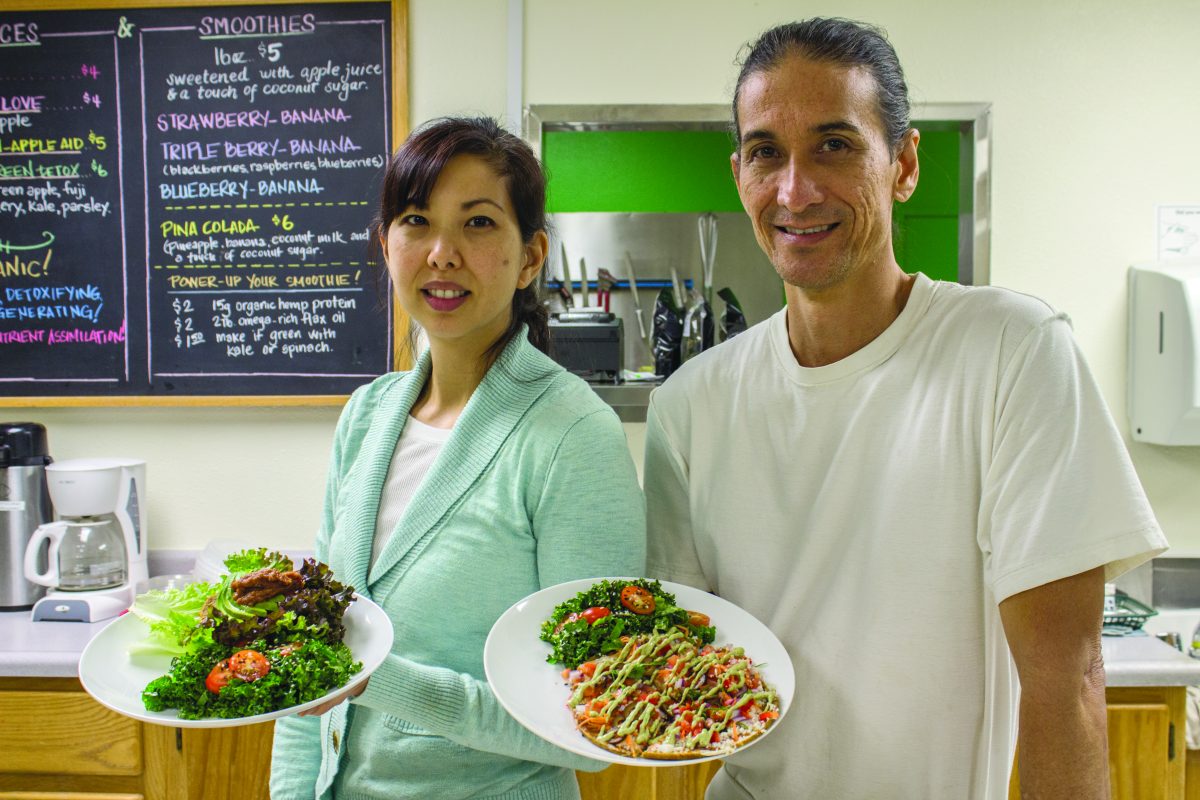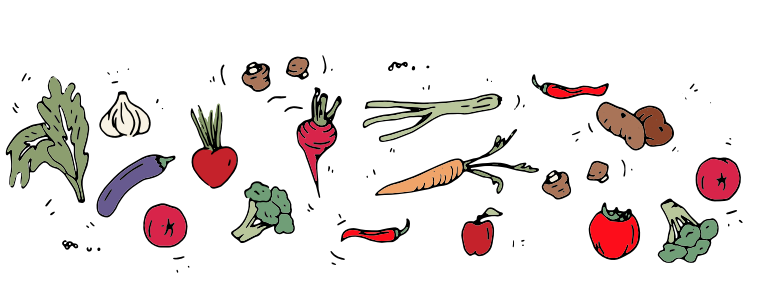Story by Megan Dougherty
Photo by Taylor Elliott
A new customer sits down at the restaurant’s counter and looks up at a chalkboard menu hanging from the ceiling. Half of the menu has the word “raw” after each entrée. Ready to try something new, she orders pizza. When her meal arrives, the dish looks familiar, but certainly not ordinary.
“It’s not the hot, drippy kind of pizza,” says Dianna Rodgers, a new customer to TruVeg, a restaurant inside South Eugene’s YMCA. What appears to be crumbly cheese is actually grated cauliflower and shredded yam. The crust is made with sprouted buckwheat and sunflower seeds. The dish itself is not hot from the oven, but instead refreshingly crisp. This was Rodgers’ first taste of a completely raw meal. “The food was great,” she says. “I ate every bit on my plate.”
The raw food movement is a community pursuing a healthier lifestyle through eating foods in their most natural form—uncooked. The diet is founded on the belief that food loses enzymes, minerals, and nutrients when heated. Raw foodists, as they call themselves, have become less of a fringe group in the past few decades. The diet has gained popularity as famous chefs and celebrities like Demi Moore have caught onto the health-conscious trend.
Rodgers’ first raw experience was at TruVeg, a restaurant that was opened by Chef Brian Igarta and his wife Crystal DuBoyce. The couple, along with their daughter Skye, moved from Hawaii and settled in Eugene, Oregon, in 2013 with the intent to promote healthy ways of eating. Igarta is a studied chef and author of three vegetarian/vegan cookbooks that include raw recipes.
“A lot of people would ask us, ‘What do you eat? Just salads?’” Igarta says. His reply: they eat much, much more. Igarta wrote his cookbooks and opened TruVeg as a way to show that vegan and raw meals can actually taste good and that raw food is more than just eating salad.
“Our whole goal is just to educate people to make better lifestyle choices,” he says. “Coming from a culinary background, we chose food.” Committed vegans, Igarta and DuBoyce first began experimenting with raw food about seven years ago. “Tasting is believing,” DuBoyce says about both her own experience and the people who come into their restaurant hesitant about trying raw food.
In addition to their menu of vegetarian dishes, TruVeg currently has raw tacos, raw pizza, and a raw burger on its menu. They attempt to make hesitant eaters more comfortable by making raw versions of classic dishes that sound familiar and safe. Igarta and DuBoyce say responses have been very positive.
“Everything is so fresh and there’s a lot of flavor in vegetables,” DuBoyce says. Customers seem to notice the difference. Fresh local vegetables are the most crucial aspect of the raw diet and some local food stores are working to cater to raw foodists in the community.
Sundance Natural Foods, a food store in South Eugene, has long been a support to raw foodists in the community. David ResSeguie has been working at Sundance for nearly 30 years and says that over this time he has seen a very dynamic shift in the popularity and demand for raw foods.
“There’s definitely always been a core movement here in Eugene for raw foods, and now there’s a lot more people who are hearing the word,” ResSeguie says. Although the essence of raw food is void of manufacturers, ResSeguie has seen food manufacturers respond to the rising popularity of raw food over the years. There are raw crackers, granola, trail mixes, and the ever-popular kale chip. ResSeguie chuckles, recalling the 15 different types of kale chips that Sundance has shelved in the past year.
Although radical proponents of the diet eat raw meat and dairy, the average raw foodist avoids anything from the animal kingdom. Similar to other popular diets, the raw food diet comes with its own spectrum of beliefs and controversies. There are differing views about the specific temperature at which food should be eaten for optimal nutrition, but it ranges from about 106 to 115 degrees Fahrenheit.
Ferale Hubbard is another passionate raw foodist who lives in Eugene. “Raw food is pure energy for the body,” she says. Her summertime diet consists of fresh local vegetables and berries, and in the cold rainy months she eats kale, cabbage, and soups with warming spice, like cardamom and cloves. Her journey with nutrition and diet has been filled with trial and error, as she experimented while trying to discover what would be best for her body. The two roads of diet and passion for nutrition converged when she discovered and settled on the raw food diet.
When Hubbard first made her diet change, she saw a lack of support and resources for raw foodists in Eugene, so she decided to initiate a solution to this problem. In 2010, Hubbard opened Raw Love, a raw food cart and catering business. Her goal, much the same as Igarta’s, is to make gourmet raw food that fulfills the cravings that the body has for cooked food. Being in the raw food business, she has experienced much of the controversy surrounding the diet.
“There are people from both extremes saying that cooked food is an addiction and you should only eat raw food,” Hubbard says. “And then people in the other spectrum saying that 50 to 60 percent of raw food is fine, and you’re going to be just as healthy.”
While raw foodists believe that eating raw is the best way to become healthier, some would suggest that some claims about the raw food diet are misleading and inaccurate. Ingrid Skoog, a Registered Dietician and faculty member in the dietetics program at Oregon State University, has strong convictions about a balanced approach to providing the body with the nutrients it needs. She says that eating raw fruits and vegetables is great; however, cooking these foods has advantages too. Science and physiology show that while heat and acids can denature proteins and break down enzymes, these are not enzymes the body uses to digest food. “The body can increase or decrease the production of digestive enzymes based on the food we consume,” says Skoog.
“It doesn’t tax your body to make more enzymes,” she says. Heat is one way we increase fiber solubility. Because many of a plant’s micronutrients (minerals and vitamins) are bound up with the fiber, heat actually helps to break apart fiber and make more of these essential nutrients easier to absorb.
Skoog agrees that all people need to incorporate more fresh fruits and vegetables into their diets, but she says that a completely raw diet is not always beneficial. “I don’t argue with a well-designed diet,” she says. “You can eat a nutritionally-balanced raw food diet if you want to. But know that it’s not because your body can’t do it.”
Regardless of whether or not eating raw is the healthier way to go, it’s hard to deny that fresh raw food tastes good.
DuBoyce, who usually works at the front counter at TruVeg, says she enjoys watching customers, such as Rodgers, experience raw food for the first time. “It makes people happy,” she says. “It’s like their taste buds light up when they taste good raw food.”
Brian and Crystal show us a lettuce wrapped burger, and a pizza made from unexpected ingredients. Both dishes include a side salad.















